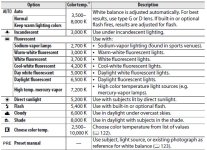Thank you for your nice comment

The main points i cannot get my head round is the white balance and af lock etc. I keep going over it in the manual but i think it is just something that will fall into place the more i read up about it.
AF lock was pretty useful for the early AF camera's, but now modern AF cameras have more focus points and most if not all you can select the focus point yourself, the main point of the focus lock is to be able to focus on something that isn't in the centre of the frame, you focus on the subject you want in focus, say a person that might be on the left or right of the frame, focus on that, select focus lock, re-position your camera then take the photo, the person will then be the main point of the focus and not the background, although I have my AF/AE lock set on A/E as I find that a much better option for me ...
Focus on the subject and self the A/F lock
Re-position the camera
And the subject will still be in focus and not the background, without the A/F lock the background would be the point of focus and not the people, hope that helps you understand a little better ...
White balance is just what is say's, years ago in the good old days of film, film was balanced to the light it was going to be exposed for, i.e daylight, or tungsten, or if you were using the wrong film you could use either a warm up or cool down filter, these days of digital you can do all that in the camera, most of the time leaving it on auto should do the trick, but this little chart should help you ...





